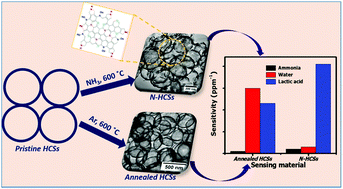Nitrogen-doped hollow carbon spheres as chemical vapour sensors†
Abstract
This study reports on low nitrogen content-doped hollow carbon spheres (N-HCSs) for use as chemical vapour sensors. The N-HCSs were prepared by a template-assisted chemical vapour deposition method followed by nitrogen doping in an ammonia atmosphere. Raman spectroscopy data displayed an increase in the ID/IG ratio of the carbons upon N-doping indicating the creation of structural defects in the hollow carbon spheres (HCSs). The XPS results showed the N-HCSs had a very low N content (0.6 at%) comprising predominantly pyridinic-N (35%) and pyrrolic-N (48%) configurations. Annealed HCSs obtained by thermal annealing in Ar exhibited a lower ID/IG ratio and higher thermal stability than the N-HCSs. The HCSs-based sensors were exposed to varying concentrations of acetone, water, lactic acid, ammonia, toluene, chloroform and methanol vapours at room temperature. Low detection limits for toluene (15 ppm), lactic acid (12 ppm) and ammonia (6 ppm) were established for the N-HCSs-based sensors. The methanol sensitivity for the N-HCSs was recorded to be 5 times higher than that of related rGO based sensors. This was ascribed to the moderate degree of graphitization, hollow carbon morphology and the electron-rich N-HCS surface. Most importantly, the water dependency for the N-HCSs was lower than that of the un-doped HCSs. This indicated the effect of heat treatment and post-nitrogen doping of the HCSs in significantly lowering the humidity dependency of the carbon. Thus, the results suggested that the N-HCSs nanostructures are potential candidates for humidity-insensitive environmental sensing devices for the detection of various chemical vapours.



 Please wait while we load your content...
Please wait while we load your content...